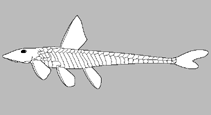Corumbataia veadeiros Carvalho, 2008
Upload your photos and videos
Google imageNo image available for this species;
drawing shows typical species in Loricariidae.
Google imageNo image available for this species;
drawing shows typical species in Loricariidae.
Classification / Names Common names | Synonyms | Catalog of Fishes(genus, species) | ITIS | CoL | WoRMS | Cloffa
Teleostei (teleosts) > Siluriformes (Catfishes) > Loricariidae (Armored catfishes) > Hypoptopomatinae
Etymology: Corumbataia: A locality, Corumbataia do Sul, in Brasil; veadeiros: Named after the Chapada dos Veadeiros, a formation characterized by flat-topped plateaus, situated to the south of the tributaries where the new species was discovered.
Etymology: Corumbataia: A locality, Corumbataia do Sul, in Brasil; veadeiros: Named after the Chapada dos Veadeiros, a formation characterized by flat-topped plateaus, situated to the south of the tributaries where the new species was discovered.
Environment: milieu / climate zone / depth range / distribution range Ecology
Freshwater; demersal. Tropical
Distribution Countries | FAO areas | Ecosystems | Occurrences | Point map | Introductions | Faunafri
South America: upper Rio Tocantins basin in Brazil.
Size / Weight / Age
Short description Identification keys | Morphology | Morphometrics
Dorsal spines (total): 2; Dorsal soft rays (total): 7; Anal spines: 1; Anal soft rays: 5; Vertebrae: 28 - 29. Distinguished from other species of Corumbataia by the following characters: absence of a raised tuft of enlarged odontodes on the supraoccipital (vs. presence); an infraorbital canal entering the infraorbital series via the sphenotic (vs.via the pterotic-supracleithrum); and caudal fin with vertical dark bars (vs. middle caudal-fin rays pigmented or one pair of hyaline areas on the dark background of the ventral and dorsal lobes) (Ref. 78746).
Life cycle and mating behavior Maturity | Reproduction | Spawning | Eggs | Fecundity | Larvae
Main reference
Upload your references | References | Coordinator : Fisch-Muller, Sonia | Collaborators
Carvalho, T.P., 2008. A new species of Corumbataia (Siluriformes: Loricariidae: Hypoptopomatinae) from Upper Rio Tocantins Basin, Central Brazil. Copeia 2008(3):552-557. (Ref. 78746)
IUCN Red List Status (Ref. 130435: Version 2024-2)
Least Concern (LC) ; Date assessed: 07 November 2018
CITES
Not Evaluated
Threat to humans
Harmless
Human uses
FAO - Publication: search | FishSource |
More information
Trophic ecology
Food items
Diet composition
Food consumption
Food rations
Predators
Food items
Diet composition
Food consumption
Food rations
Predators
Ecology
Ecology
Ecology
Population dynamics
Growth parameters
Max. ages / sizes
Length-weight rel.
Length-length rel.
Length-frequencies
Mass conversion
Recruitment
Abundance
Growth parameters
Max. ages / sizes
Length-weight rel.
Length-length rel.
Length-frequencies
Mass conversion
Recruitment
Abundance
Life cycle
Reproduction
Maturity
Maturity/Gills rel.
Fecundity
Spawning
Spawning aggregations
Eggs
Egg development
Larvae
Larval dynamics
Reproduction
Maturity
Maturity/Gills rel.
Fecundity
Spawning
Spawning aggregations
Eggs
Egg development
Larvae
Larval dynamics
Anatomy
Gill area
Brain
Otolith
Gill area
Brain
Otolith
Physiology
Body composition
Nutrients
Oxygen consumption
Swimming type
Swimming speed
Visual pigments
Fish sound
Diseases & Parasites
Toxicity (LC50s)
Body composition
Nutrients
Oxygen consumption
Swimming type
Swimming speed
Visual pigments
Fish sound
Diseases & Parasites
Toxicity (LC50s)
Genetics
Genetics
Heterozygosity
Heritability
Genetics
Heterozygosity
Heritability
Human related
Aquaculture systems
Aquaculture profiles
Strains
Ciguatera cases
Stamps, coins, misc.
Aquaculture systems
Aquaculture profiles
Strains
Ciguatera cases
Stamps, coins, misc.
Tools
E-book | Field guide | Length-frequency wizard | Life-history tool | Point map | Classification Tree
| Catch-MSY |
Special reports
Download XML
Internet sources
AFORO (otoliths) | Aquatic Commons | BHL | Cloffa | BOLDSystems | Websites from users | Check FishWatcher | CISTI | Catalog of Fishes: genus, species | DiscoverLife | ECOTOX | FAO - Publication: search | Faunafri | Fishipedia | Fishtrace | GenBank: genome, nucleotide | GloBI | Google Books | Google Scholar | Google | IGFA World Record | MitoFish | Otolith Atlas of Taiwan Fishes | PubMed | Reef Life Survey | Socotra Atlas | Tree of Life | Wikipedia: Go, Search | World Records Freshwater Fishing | Zoobank | Zoological Record
Estimates based on models
Phylogenetic diversity index (Ref. 82804): PD50 = 0.5625 [Uniqueness, from 0.5 = low to 2.0 = high].
Bayesian length-weight: a=0.00851 (0.00374 - 0.01935), b=3.09 (2.90 - 3.28), in cm total length, based on LWR estimates for this (Sub)family-body shape (Ref. 93245).
Trophic level (Ref. 69278): 2.3 ±0.1 se; based on size and trophs of closest relatives
Fishing Vulnerability (Ref. 59153): Low vulnerability (10 of 100).




